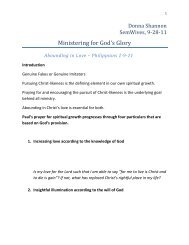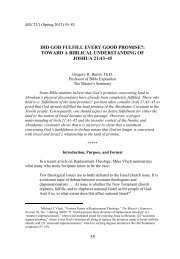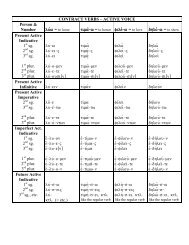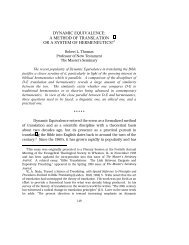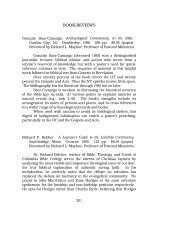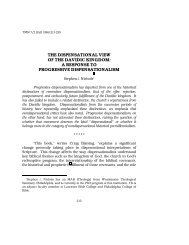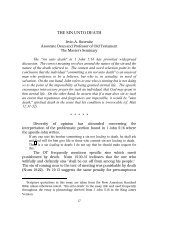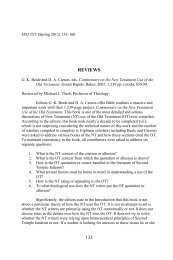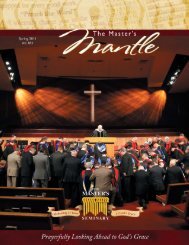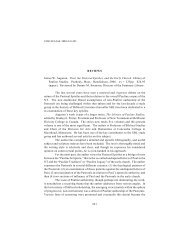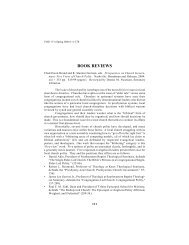Inductive and Deductive Methods as Applied to OT Chronology
Inductive and Deductive Methods as Applied to OT Chronology
Inductive and Deductive Methods as Applied to OT Chronology
Create successful ePaper yourself
Turn your PDF publications into a flip-book with our unique Google optimized e-Paper software.
114 The M<strong>as</strong>ter’s Seminary Journalmodern analysis of the time of Tiglath-Pileser is that of Hayim Tadmor. 30 Followingis a brief summary of the facts regarding the controversy, <strong>as</strong> derived primarily fromTadmor’s work.1. Tiglath-Pileser’s records state that he received tribute from various western kings whenhe w<strong>as</strong> in the city of Arpad. According <strong>to</strong> Luckenbill’s translation, the only entry in theAssyrian Eponym Chronicle (AEC) that indicated when Tiglath-Pileser w<strong>as</strong> “in Arpad”w<strong>as</strong> the entry for 743 B.C., a date consistent with Thiele’s <strong>and</strong> McFall’s dates for Menahem.The full entry for 743 <strong>as</strong> given by Luckenbill is: “in the city of Arpadda. A m<strong>as</strong>sacre<strong>to</strong>ok place in the l<strong>and</strong> of Urartu.” 31 Tadmor wrote the following regarding Luckenbill’stranslation: “This translation of this crucial line, however, h<strong>as</strong> been disputed by severalscholars. It should most likely be taken <strong>to</strong> mean that the army of Urartu suffered a defeatin (the l<strong>and</strong> of) Arpad, so that the earliest occ<strong>as</strong>ion for the payment of such tribute wouldbe 740, when Arpad fell following a three-year siege.” 32 However, Tadmor’s translationcontradicts the cus<strong>to</strong>mary usage in the AEC of the phr<strong>as</strong>e “in (a place).” This normallymeans that the reigning king of Assyria w<strong>as</strong> in that place. Furthermore, the determinativefor Arpad is uru, meaning a city, not the determinative for a l<strong>and</strong>. It is also difficult <strong>to</strong>accept that Urartu (Ararat/Armenia) w<strong>as</strong> defeated in the city, consistent with the rest ofTadmor’s translation. For all these re<strong>as</strong>ons, Luckenbill’s translation is <strong>to</strong> be preferred, <strong>and</strong>that translation is consistent with Menahem’s tribute being delivered when Tiglath-Pileserw<strong>as</strong> “in Arpad,” in 743 B.C.2. The main re<strong>as</strong>on that Tadmor <strong>and</strong> other Assyriologists <strong>as</strong>sign Menahem’s tribute <strong>to</strong> 738is because an inscription from late in Tiglath-Pileser’s reign gave a list of tributary kings,including Menahem, just before an entry describing events in the Assyrian monarch’sninth year, 737 B.C. The <strong>as</strong>sumption w<strong>as</strong> made that the tribute from the kings w<strong>as</strong> allgiven in the preceding year. But this would not necessarily follow if the tribute list w<strong>as</strong>a summary list. Summary lists were very common in Assyria <strong>and</strong> elsewhere in the ancientNear E<strong>as</strong>t. They lump <strong>to</strong>gether all the kings giving tribute or all the geographical regionsconquered, irrespective of the year in which the tribute w<strong>as</strong> given or the region conquered.Thiele expected that Tadmor’s publication of the Iran Stele, which contains the earlies<strong>to</strong>f all extant Assyrian records mentioning Menahem’s tribute, would show that the tributelist in the later Assyrian records w<strong>as</strong> a summary list. 33 Thiele died in 1986 <strong>and</strong> Tadmordid not publish his translation of the Iran Stele until his book on Tiglath-Pileser appearedin 1994. In that publication it w<strong>as</strong> shown that the tribute list of the Iran Stele w<strong>as</strong>definitely a summary list. The implication is that the later list, the list from whichAssyriologists make the inference that the tribute w<strong>as</strong> in 738, w<strong>as</strong> also a summary list,copied either from the Iran Stele or from an earlier pro<strong>to</strong>type from which both lists werecopied. The Iran Stele therefore vindicated Thiele by its evidence that the tribute listscontaining the name of Menahem are summary lists, so that, b<strong>as</strong>ed only on the30 Hayim Tadmor, The Inscriptions of Tiglath-Pileser III, King of Assyria (Jerusalem : IsraelAcadem y of Sciences <strong>and</strong> Humanities, 1994).31 ARAB 2.436.32 Tadmor, Inscriptions 268.33 Thiele, Mysterious Numbers 162.



